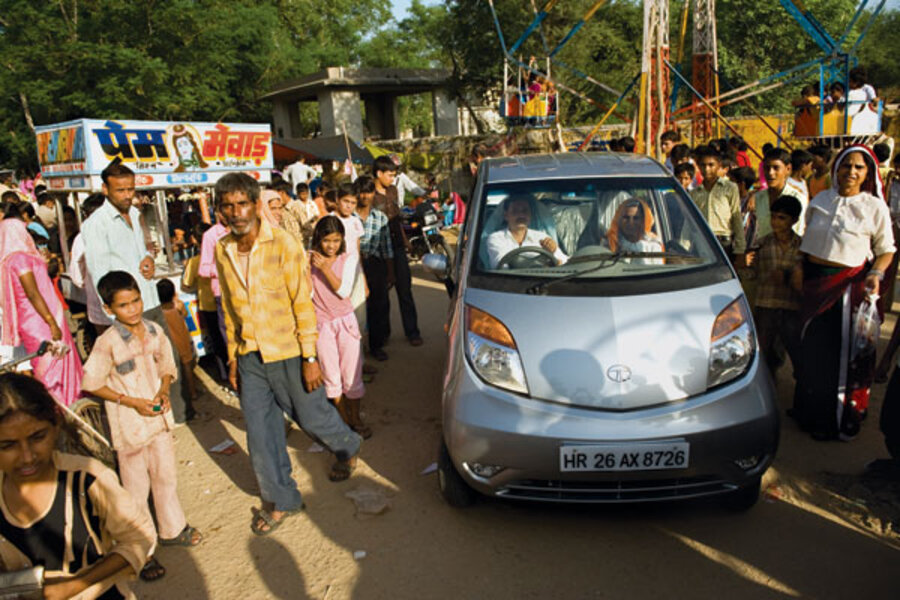In India, rich and poor line up for $2,000 Nano
Loading...
| Nakhrola, India
• A local, slice-of-life story from a Monitor correspondent.
Months after buying the shiny silver car, farmer Satish Kumar still keeps the plastic wrap on the seats. Most days, his Tata Nano – his first car – sits in the front yard, proudly displayed between the brick pillars of a homemade carport. Tucked from sight are a couple of cows and a humble scooter that still is driven a lot more than the four-wheeled wonder.
The Kumars actually don’t much need a car: Mr. Kumar works in the fields around his house; Mrs. Kumar stays at home; and the kids go to school by bus. The car proves useful for those special occasions when the family wants to arrive together – and in style. “I’m mainly concentrating on using it socially – taking my whole family to weddings and other family functions,” he says.
For Tata, the Indian automaker, Kumar belongs to a new class of customer, thanks to the Nano’s price of just $2,000. But while the Nano spurred much chatter about what it allows the middle class to do, Kumar suggests the Indian consumer may be more smitten with what the car allows them to be. “I think the Nano is actually used as a signaling device,” says Sourabh Mishra, chief strategy officer at marketing firm Saatchi & Saatchi India. “It’s signaling, ‘I’m now part of a group who can afford a lifestyle that hitherto was not possible to me.’ ”
Some 10 months after Nano’s launch, Tata has booked sales of 206,703 cars; 17,000 Nanos have been delivered. Some 70 percent of bookings came from nonmetro areas.
In Delhi showrooms, there are folks like Kumar, whose farming village is on the outskirts of the city. But there are also the wealthy looking for a car for their teen or a chance to own the latest “status symbol,” says Resham Singh, showroom manager at a Tata dealership: “We were expecting people to come who were ... on two-wheelers, or in lower-model cars. It was a total surprise – people were coming … who have two or three cars, but wanted the Nano just for the sake of having it.”
Nakhrola, where Kumar grows wheat, lentils, and vegetables, is gentrifying. The suburb of Gurgaon is closing in, chewing up farmland and spitting out high-rise towers. Kumar lives down a dirt lane that hosts as many tractors as cars. One house has an Audi, while the next has little but trash in the yard. In one corner lies an Asian Tiger fitness gym; in another runs an open sewer. Still, “keeping up with the Joneses” – or the Joshis – is part of life.
“There are rich people – landowners – and they all have cars,” says Kumar. “Now what they feel is that I have something new and they don’t, and they should also have it.”
Such peer pressure is common in India, says Deepesh Rathore, an India-based analyst with Global Insight. “It is about at least parking one car in your garage because the neighborhood is a car-owning neighborhood.”
Indeed, just four or five times has Kumar taken the car for long drives. As his mother, proud that her son bought the car, says: “We can’t go anywhere because it’s expensive.”





